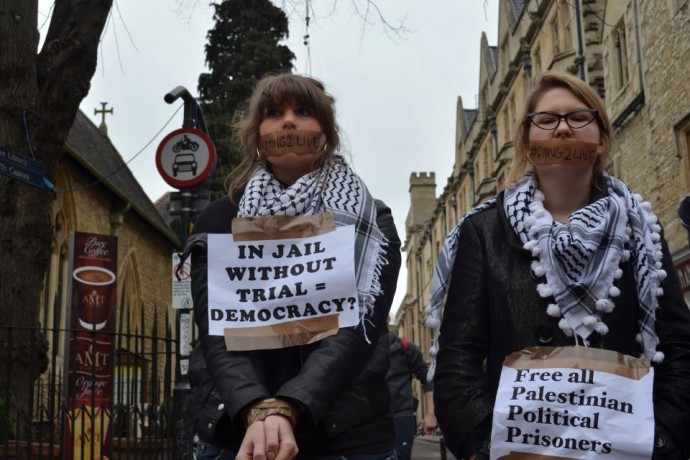
(MintPress)— Protesters across the United States took part in the National Occupy Day in Support of Prisoners on Monday, February 20th. The day of action follows a wave of hunger strikes that have swept through California prisons starting last summer, reportedly resulting in the death of one prisoner earlier this month.
Hunger strikes, a form of non-violent resistance historically used as an act of political protest by activists like Mahatma Gandhi, Alice Paul, and Nelson Mandela, remain a powerful tool for protesters in the 21st century.
Coinciding with the height of the Occupy movement last fall, as many as 12,000 prisoners across 13 California prisons are believed to have taken part in hunger strikes to protest poor conditions in Administrative Segregation Units (ASUs) that began at Pelican Bay State Prison in July.
While the majority of prison protests subsided last fall, intermittent hunger strikes started back up in Corcoran, California in December. Earlier this month, a protester in the Corcoran State Prison was found dead in his cell less than a week after he began participating in one of the strikes.
Terry Thornton, a spokeswoman for the California Department of Corrections and Rehabilitation (CDCR), reported that Christian Alexander Gomez, 27, died on February 2 after resuming a hunger strike with 31 other inmates in ASUs. Final autopsy reports have not been published yet.
Gomez, sentenced to life in prison for first-degree murder and attempted murder, was placed in an ASU after being charged with attacking a fellow prisoner. Gomez was participating in a protest against restrictions on access to legal services, health care, sanitary food, telephones, education services and other human rights demands when he died.
Theresa Cisneros, a spokeswoman for Corcoran State Prison, said prisoners in ASUs are meant to stay only temporarily while being transferred to other units and therefore have limited access services such as exercise yards, education services, or radios.
However, a 2009 special review by the Office of the Inspector General found that several California state prisons violated CDCR policies by extending the length of ASU confinements and restricting inmates’ due process rights. ASU violations potentially cost the CDCR $10.9 million.
In some cases, inmates were held in ASU confinement for well over 200 days, with some instances ranging from several years to several decades. Many prisons that confine inmates past 30-days did not apply for the mandatory approval from CDCR in order to do so.
According to Molly Porzig, an organizer with Prisoner Hunger Strike Solidarity Coalition, ASUs “are often used to punish prisoners who are jail house lawyers or who have organized with their fellow prisoners to make political demands.”
Thornton told Reuters that the Corcoran hunger strike ended on February 13. However, activists from groups like Solidarity Watch and Prison Hunger Strike Solidarity believe protests are still going on inside the prison.
Even if the current hunger strike has ended, a new strike is likely to start again soon unless CDCR complies with the demands of the prisoners. ”
.
Khader Adnan – 65 days and counting
The hunger strike in Corcoran, CA coincides with a similar struggle happening halfway across the world, where a Palestinian prisoner is waging a hunger strike against what he deems the humiliation that Palestinians face under Israel’s military justice system.
Khader Adnan, 33, began a hunger strike on December 18, one day after being arrested at his home near the northern West Bank city of Jenin. Adnan is being held under “administrative detention,” which allows Palestinians to be held without charge for a period of up to six-months that can be indefinitely renewed.
The Israeli military told Al Jazeera, “Khader Adnan was arrested with an administrative arrest warrant for activities that threaten regional security. This warrant was authorised by a judicial review.”
Adnan, previously convicted of being a spokesperson for the Islamic Jihad Palestinian resistance group, has not been officially charged and claims he does not know what he is suspected of doing. Unless he is charged and brought to trial, Adnan demands to be released immediately.
309 Palestinians are currently being held under administrative detention. Last week in the Palestinian Territories, thousands of protesters against Israel’s administrative detention law and rallied in support of Adnan.
The hunger strike, which has lasted over 65 days, is believed to be the longest by a Palestinian prisoner. According to an Israeli medical rights group, Adnan is in “immediate danger of death.” Adnan is being held in a hospital where he is being kept alive through electrolyte-infused liquids while he refuses food.
The Israeli Supreme Court is set to hear Adnan’s appeal on Tuesday. However, like the prisoners in Corcoran, Adnan will continue his hunger strike until his demands are meant, even if it leads to his death.
Worldwide, thousands of prisons continue to participate in hunger strikes in the United States, the Palestinian Territories, Bahrain, Iran, and Guantanamo Bay to list a few. Just last month in Kyrgyzstan, 6,400 prisoners went on a nationwide hunger strike against prison conditions – 1,175 prisoners sewed their mouths shut in protest.
One California inmate wrote of the widespread hunger strikes in a letter, saying, “The struggle that is being fought in this ASU at Corcoran State Prison is only a small part of a bigger struggle that is being fought, and that will be continuously fought, against the oppression that is evident in all parts of the world today.”
Update: Khader Adnan ended his 66 day hunger strike on 21 February, 2012 after the Israeli Court set a date for his release on 17 April, 2012, according to officials.


